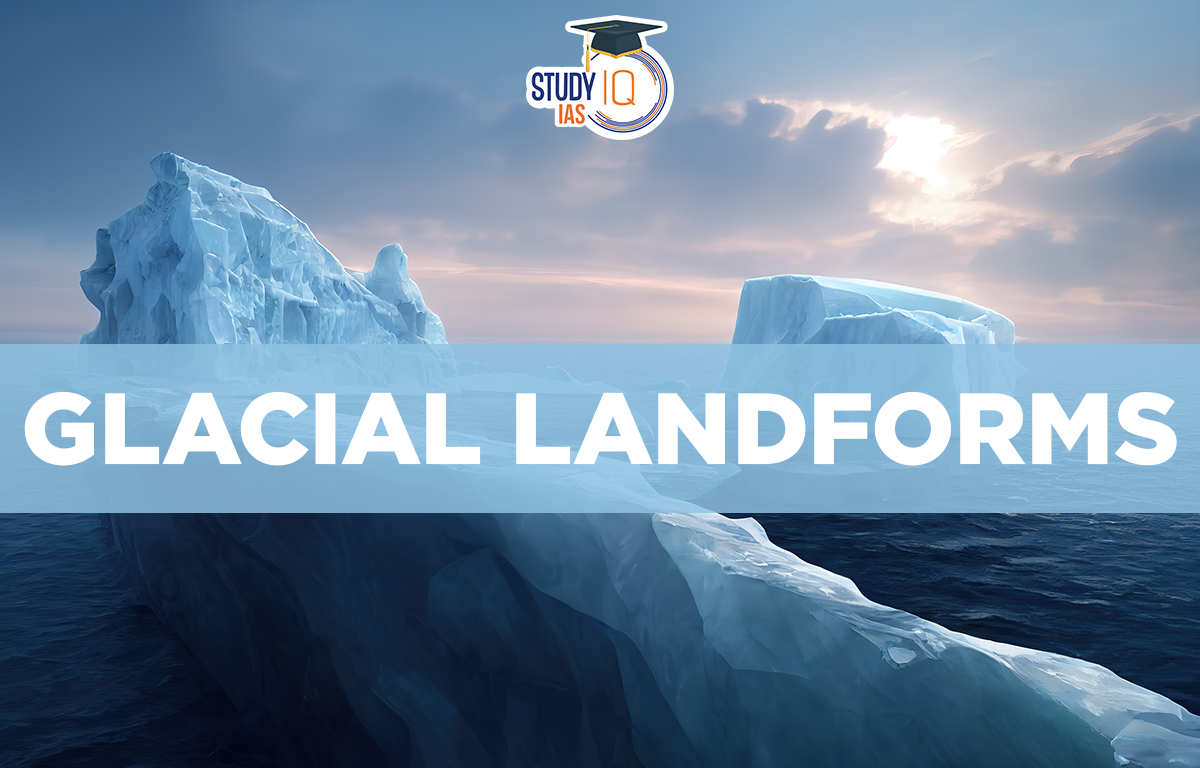Table of Contents
Glacial Landforms
Glacial Landforms: Glacial landforms are the landforms produced by the glaciers. Most of these landforms were created when big ice sheets moved during the last ice ages. Even in places where there are not any glaciers now, you can still find these landforms. If you put a straight line of sticks across a glacier, they will slowly curve as they go down the valley. This shows that the middle of the glacier moves faster than the edges.
What is a Glacier?
A glacier is a big, slow-moving mass of ice that moves across land. It is wider at the top and gets thinner as it goes down. Even though it is made of ice, a glacier can move because of the heavy snow on top. The sides and bottom move slowly because they rub against the ground and walls of the valley. Most of Earth’s water, about 97.2%, is in the oceans, while only 2.1% is in glaciers.
Glacial Landforms Formation
Glaciers begin to form in places where more snow falls each year than melts. When the snow falls, it starts to compress and become denser. This process is called firnification, where the snow turns into firn, a thick, grainy ice. As the firn builds up to about 50 meters (160 feet) thick, it becomes solid ice. The weight of the ice causes the glacier to break off pieces, a process known as calving. Different parts of the glacier move at different speeds; the ice in the center moves faster than the ice at the bottom.
Landforms by Glaciers
Glaciations create different landforms in low areas and high areas. In lowlands, they leave behind deposits, while in highlands, they cause erosion. Glaciers use two main methods to erode valleys:
Plucking
Plucking happens when glaciers freeze onto rocks and pull out pieces, dragging them away.
Glacier Abrasion
Glacier abrasion occurs when debris frozen in the glacier scrapes and scratches the valley floor, polishing it. There are two main types of glacial landforms: Depositional (where materials are left behind) and Erosional (where materials are worn away).
Glacial Landforms Depositional
Landscapes in mid- and high-latitude alpine regions have been significantly shaped by glaciers. The main glacial depositional landforms include
- Outwash Plain
- Drumlins
- Esker
- Glacial Till
- Kettle holes
- Moraine
- Kame Terraces
Outwash Plain
An outwash plain forms when a glacier melts at its lowest point, leaving behind layers of materials like rock debris, clay, sand, and gravel.
Esker
An esker is a winding ridge made of mixed materials like rock, gravel, and clay that runs along a glacier in an outwash plain. Eskers look like embankments and are often used to build roads.
Kame Terraces
Kame terrace are broken ridges or bumps made of mixed materials found in an outwash plain.
Drumlin
A drumlin is a boat-shaped hill formed by materials deposited by a glacier in an outwash plain.
Kettle Holes
Kettle holes are depressions that form in an outwash plain when some of the deposited material sinks, creating a basin.
Moraine
A moraine is a general term for rock fragments, gravel, and sand that glaciers carry. Depending on where they are located, moraines can be classified as ground moraine or end moraine.
Glacial Landforms Erosional
The main glacial erosional landforms include
- Criques
- Glacial Valleys/Troughs
- Aretes and Horns
1. Cirque
A cirque is bowl-shaped and created by glaciers. It has steep sides on three sides, an open end on one side, and a flat bottom. When the ice melts, a cirque can turn into a tarn lake. It has a curved cliff at the back called the headwall, and the open end faces downhill. Cirques can have shallow basins that often form lakes. You can see signs of heavy glacial erosion in the basin and the headwall.
2. Glacial Valleys/Troughs
A U-shaped valley is an original stream-cut valley that has been changed by glaciers. This valley is in the mature stage of its formation. Because glaciers are heavy and move slowly, they erode the valley evenly, both side to side and top to bottom. This creates a steep-sided valley with a flat bottom.
3. Aretes and Horns
Aretes are sharp, knife-edged ridges formed by glaciers between two U-shaped valleys. As glaciers erode the rock, they leave these ridges higher up in the valleys. Often, there is a low area called a col between two aretes.
Many cirques are found together on the sides of large mountain ranges, like the Alps. When glaciers wear down the tops of these mountains, they create sharp peaks called horns. These peaks have steep cliffs on their sides and are separated by aretes.
Glacial Landforms Significance
Rivers and Glaciers
Many rivers get their water from glaciers. For example, the Ganga River starts at the Gangotri Glacier in the Himalayas and provides freshwater and power to people in India and Bangladesh.
Freshwater Reservoirs
Glaciers hold about three-quarters of the Earth’s freshwater, making them the largest reservoirs of fresh water. When glaciers melt, they affect the temperature of rivers downstream.
Support for Aquatic Life
In mountain areas, many aquatic species need the cold water from glaciers to survive. Some insects and fish, like trout and salmon, depend on the cooling effects of glacial meltwater.
Resources from Glaciers
Glaciers also provide important resources for people. The soil left by glaciers, called glacial till, is good for farming, and the sand and gravel they deposit are used to make concrete and asphalt.
Glacial Landforms UPSC
A glacier is a sizable, long-lasting mass of crystalline ice, snow, rock, sediment, and water that forms on land and slides down a slope due to gravity and its weight. They are delicate climate change indicators. 97.2% of the water on Earth is in the oceans and inland seas, compared to 2.1% in glaciers.
There are various kinds of glaciers, and throughout their existence, they produce both erosive and deposited landforms. You can use the many glacial depositional landforms mentioned in this article to prepare for the UPSC Exam.
Other Indian Geography Topics
Other Fundamental Geography Topics


 Story of Meera Bai and Her Devotion For ...
Story of Meera Bai and Her Devotion For ...
 Desert Climate, Distribution, Climatic C...
Desert Climate, Distribution, Climatic C...
 Deserts of India Map, Features of Thar D...
Deserts of India Map, Features of Thar D...





















